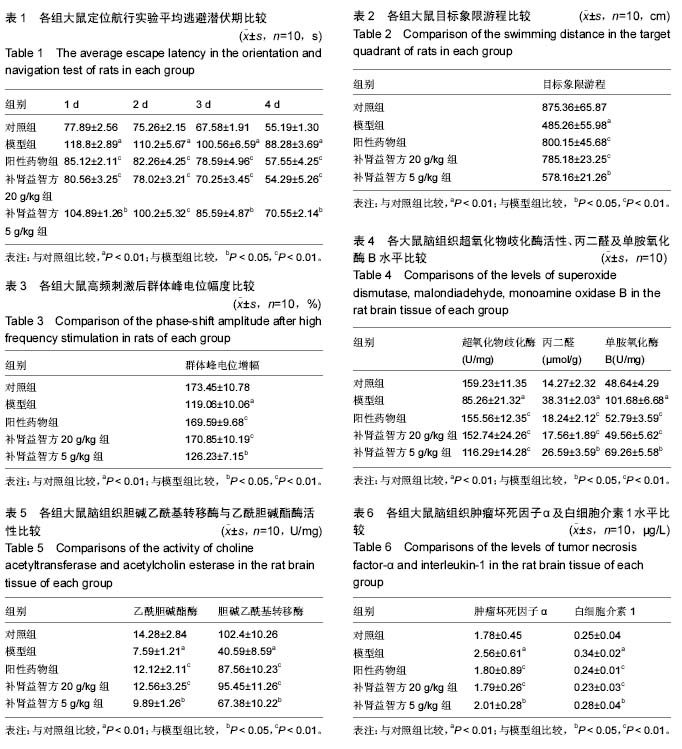| [1] JF D. Alzheimer's disease: a global challenge for the 21st centxiry. Lancet Neurol. 2009;8(12):1082-1083.
[2] 李帆,黄玉玲.老年痴呆症的现状分析及健康教育[J].当代医学,2012,18(22):159.
[3] 王廷玉,潘朝霞,何秀贞,等.老年痴呆患者呼吸睡眠障碍的研究[J].中国医药科学,2012,2(14):255-257.
[4] 闫敬来,陈燕清.老年痴呆病机的中医学认识概述[J].中华中医药杂志,2008,23(7):640.
[5] Grundman M. Vitamin E and Alzheimer disease: the basis for additional clinical trials. Am J Clin Nutr. 2000; 71:630-636.
[6] 王馨,李晶,廖一兰,等.巴戟天水提物对老年痴呆模型大鼠的保护作用研究[J].中国药房, 2013,(31):2908-2910.
[7] 王忆杭,肖培根,刘新民.连翘酯苷对拟AD复合动物模型小鼠学习记忆的改善作用及其机制研究[J].中国实验动物学报, 2011,19(5):424-427
[8] Heneka MT, O'Banion MK. Inflammatory processes in Alzheimer sdisease.J Neuroimmunol. 2007;184(1-2): 69-91.
[9] 邱瑜,陈红志.毒蕈碱受体激动剂治疗阿尔茨海默病的研究进展[J].国外医药:合成药,生化药,制剂分册,2000, 21(6):324-32
[10] Kou J, Zhu D, Yan Y. Neuroprotective effects of the aqueous extraet of The Chinese medieine Danggui-Shaoyao-san on aged mice. J Ethno Pharmaeol. 2005;97(2):313-318.
[11] 刘春风,戴永萍,章春园,等.尼莫的平对Alzheimer病大鼠海马和额叶细胞外液氨基酸的影响[J].临床神经病学杂志,2000,13(5):272-274.
[12] 刘光,宋盛青,陈克,等.补肾益气活血法治疗肾虚血瘀型阿尔兹海默病疗效观察[J].四川中医,2009,27(11):72-73.
[13] 陈荣,殷群,路亚娥.益智醒脑汤配合针灸治疗痰瘀闭阻型老年痴呆症 58例[J].陕西中医,2007,28(6):670-671.
[14] 白振忠,靳国恩,芦殿香,等.藏药七十味珍珠丸对老年痴呆模型大鼠学习记忆和超氧化物歧化酶丙二醛的影响[J].青海医学院学报, 2011,32(1):29-31
[15] 王红梅,宋彩梅,刘新民,等.六味地黄丸对肾虚型老年痴呆动物模型的改善作用[J].中国实验方剂学杂志,2012, 18(5): 112-115.
[16] 揣国钢.开窍益智方对亚急性衰老小鼠学习记忆功能的影响[D].扬州大学,2010.
[17] 孙景波,华荣,何莉娜. 清脑通络方对老年痴呆模型大鼠学习记忆功能的改善作用[J].陕西中医,2009,30(8):1095-1097.
[18] 饶燕,赖世隆,胡镜清,等. 补肾益智方对老年性痴呆大鼠突触传递长时程增强的影响[J]. 广州中医药大学学报, 2000,17(2):109-110.
[19] 王爱梅,未小明,李弋,等.旱莲草对老年痴呆模型大鼠空间学习记忆及海马神经元突触可塑性的影响[J].神经解剖学杂志,2015,31(1):73-78.
[20] 李钟勇,张鹏.美洛昔康对老年痴呆模型大鼠学习记忆能力及脑组织SOD,MAO-B,MDA的影响[J]中国现代应用药学,2011,28(2):99-103.
[21] 周丽薇,武美娜,韩维娜,等.Aβ25-35伤害大鼠空间学习记忆和在体海马长时程增强的联合研究[J].神经解剖学杂志,2012,28(3):263-267.
[22] Mark P,Guo Q,Furukawa K,et al. Presenilins,the endo plasmic reticulum, and neuronal apoptosis in Alzheimer’s disease. J Neurochem. 1998; 70:1-14.
[23] 钟振国,刘茂才,赖世隆.补肾益智方对由Aβ片段神经毒性诱导NG108-15细胞老年性痴呆模型神经递质释放影响的研究[J].中国中西医结合杂志,2002,22(1):50.
[24] 李静,周华东,王延江,等.海马注射-淀粉样蛋白建立阿尔茨海默病大鼠模型的实验研究[J].中国临床神经学,2008, 16(5):467-471.
[25] 冯荣芳,冯亚青,吕佩源.阿尔茨海默病动物模型研究进展[J].脑与神经疾病杂志,2008,16(6):724-726.
[26] 冯思民.补肾益智方对AD大鼠学习记忆能力及神经生长因子表达的影响[D].广州中医药大学,2009.
[27] 庞来祥, 沈君礼, 杨苏亚,等.健脑生智口服液对老年痴呆模型大鼠脑胆碱酯酶活性等指标的影响[J].西北药学杂志,2010,25(6):439-441.
[28] Kim JM,Kim S,Kim DH, et al. Neuroprotective effect of forsythiaside against transient cerebral global ischemia in gerbil. Eur J Pharmacol. 2011;660(2-3):326-333.
[29] Rehman HU, Masson EA. Neuroendocrinology of ageing. Age Ageing. 2001;30(4):279-287.
[30] Yamaguchi Y,Kawashima S.Effects of amyloid-Aβ(25 – 35) on passive avoidance , radial armmaze learning and choline acetyl transferase activity in the rat. Eur J Pharmacol. 2001;412(3):265-272.
[31] Henderson VW, Benke KS, Green RC,et al. Post menopausal hormone therapy and Alzheimers 'disease risk: inter action with age.J Neurol Neurosurg Psychiatry. 2005;76(1):103-105.
[32] 杨斌.复方地黄对老年痴呆动物模型学习记忆能力的影响[J].中国实验方剂学杂志, 2011,17(3):195-196.
[33] 张忠立,左月明,王秋红,等.黑水缬草对老年痴呆模型大鼠脑内iNOS、COX-2 和IκB-α表达的影响[J].中药材, 2010, 33(4):581-583.
[34] 钟振国,赖世隆,刘茂才,等.补肾益智方对AD细胞模型影响的研究[J].现代中西医结合杂志,2002,11(15):1430-1432.
[35] Kakimura J,Kitamura Y,Takata K,et al.Microglial activation and amyloid clearance induced by exogenous heat-shock proteins. Faseb J. 2002;16(6):601-603.
[36] 盛树力.老年性痴呆:从分子生物学到临床诊断[M].北京:科学技术文献出版社, 1999:126-138.
[37] 王爱梅,未小明,李弋,等.旱莲草对老年痴呆模型大鼠空间学习记忆及海马神经元突触可塑性的影响[J]. 神经解剖学杂志,2015, 31(1): 73-78.
[38] 张均田.神经药理学研究进展[M].北京:人民卫生出版社, 2002:16-28. |

